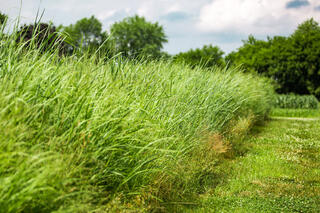Nitrate leaching in perennial systems compare favorably to corn crops over time

Perennial cropping systems leached less nitrogen into surface and ground water over a seven-year growing period.
The Science
Leaching from annual corn crops is a primary source of nitrate (NO3−) pollution of ground and surface waters. From 2009 through 2015, GLBRC scientists compared nitrate leaching from five perennial systems to that of corn. Perennial crops were found to leach similar levels of nitrate to corn in the first two years after planting, and far less over the course of the seven-year trial.
The Impact
Bioenergy cropping systems, planted in areas such as marginal lands not suitable for corn production, could ameliorate nitrate pollution in agricultural landscapes. The sandy soil at the GLBRC biofuel cropping system experiment contrasts with similar nitrate leaching studies conducted on finer soils elsewhere in the US Midwest, giving scientists and farmers new information about the ecological impacts of farming practices.
Summary
Excess nitrate originating from agricultural lands poses a major concern for drinking water quality. Nitrate leaching is also a known driver of excess greening of surface waters, creating habitats where there isn’t enough oxygen for fish and other aquatic life to survive. Over a seven-year growing period, GLBRC scientists compared leaching from annual corn crops to perennial bioenergy cropping systems including switchgrass, miscanthus, and poplar as well as native grasses and restored prairie. During the establishment phase – in the first two years of the study – these perennial cropping systems leached nitrate at similar rates to corn. Over the seven-year period, however, perennial cropping systems leached far less nitrate. Thus, the perennial cropping systems evaluated here could reduce nitrate pollution in agricultural landscapes.
Contacts (BER PM)
N. Kent Peters
Program Manager
Office of Biological and Environmental Research
kent.peters@science.doe.gov, 301-903-5549
Corresponding Author
Stephen K. Hamilton
Professor
Michigan State University
hamilton@msu.edu
Funding
US Department of Energy, Office of Science, Office of Biological and Environmental Research under Award no. DE-SC0018409, and by the USDOE Great Lakes Bioenergy Research Center (DOE BER Office of Science DEFC02-07ER64494). Support was also provided by the National Science Foundation Long-term Ecological Research Program (DEB 1027253 and 1637653) at the Kellogg Biological Station, and by Michigan State University AgBioResearch.
Publications
M.Z. Hussain, et al. “Nitrate Leaching from Continuous Corn, Perennial Grasses, and Poplar in the US Midwest.” Journal of Environmental Quality (2019). [DOI: 10.2134/jeq2019.04.0156]
Related Links
https://acsess.onlinelibrary.wiley.com/doi/full/10.2134/jeq2019.04.0156